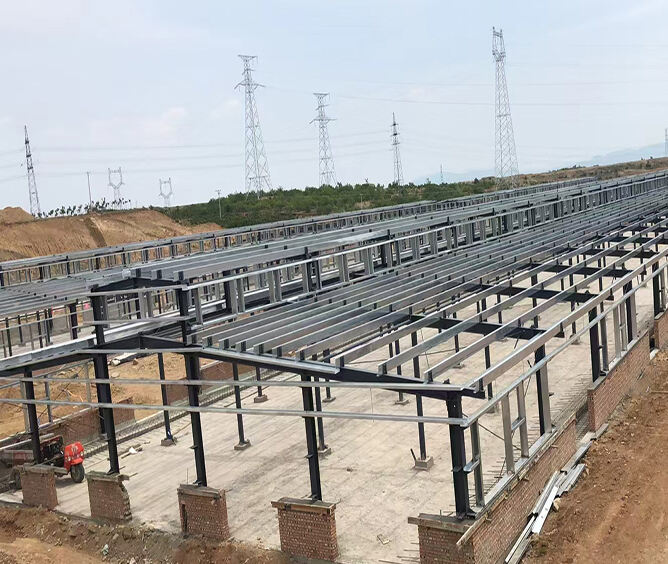What Are the Key Advantages of Steel Structures in Modern Construction?
Unmatched Strength & Structural Integrity in Steel Structures
High Strength-to-Weight Ratio for Efficient Design
Steel stands out in the world of construction due to its exceptional strength-to-weight ratio. This feature allows architects and builders to craft innovative designs while ensuring optimal load-bearing capabilities. Consequently, the use of steel minimizes material usage without compromising structural integrity. One of the key benefits of this property is the ability to create longer spans and taller structures without intermediate supports, making it possible to design open-plan spaces that are both functional and aesthetically pleasing. For example, in high-rise buildings and large open spaces like sports arenas, steel's strength supports expansive, column-free areas that concrete cannot achieve as effectively.
Research underscores the advantage of steel structures in achieving significant weight reduction compared to traditional materials, such as concrete. This not only enhances architecturally innovative approaches but also augments overall energy efficiency. Transportation of steel components is more economical due to their lightweight nature, and construction requires less energy-intensive processes. Thus, when considering sustainable and efficient design options, steel remains a preferred choice for both modern and conventional constructions.

Resistance to Corrosion and Extreme Weather Conditions
Steel structures are renowned for their resistance to corrosion, particularly when finished with appropriate coatings. This feature is crucial for extending the lifespan of buildings and reducing maintenance needs over time. Modern treatments and technologies now ensure that even in harsh environments, steel remains robust and retains its structural integrity. Compared to materials that require frequent upkeep, steel's durability offers a significant advantage in terms of both cost and time savings in maintenance.
Moreover, steel is engineered to withstand extreme weather conditions, including heavy winds and seismic activities, which makes it suitable for a wide range of geographic locations. According to industry studies, the durability of steel constructions not only results in lower long-term repair costs but also decreases the frequency of replacements, translating into a sustainable choice for many builders. The capability to endure such conditions ensures a reliable and lasting framework for various edifices, whether they exist in hurricane-prone areas or earthquake zones, thereby safeguarding both the structure and its inhabitants.
Accelerated Construction Timelines with Prefabricated Steel
Faster Erection Compared to Traditional Materials
Prefabricated steel components have revolutionized construction by allowing rapid on-site assembly, which significantly shortens project timelines. This efficiency minimizes delays that often occur due to adverse weather or site conditions, ensuring projects meet deadlines without sacrificing quality. Furthermore, the use of prefabricated steel reduces on-site labor requirements, as it allows for simultaneous site preparation and material fabrication, leading to optimized resource allocation. Studies confirm that projects utilizing prefabricated steel can be completed up to 50% faster than those relying on traditional building techniques. Thus, adopting prefabricated steel construction enhances both the speed and reliability of project completion, offering a compelling advantage over conventional methods.
Streamlined Steel Warehouse Construction Services
Steel warehouses benefit from pre-engineered solutions that streamline the construction process, making them ideal for quick deployment. These services often provide comprehensive packages that cover everything from design and manufacturing to assembly, offering clients a convenient one-stop solution. By integrating advanced project management strategies, streamlined steel warehouse construction not only improves cost efficiency but also maximizes space utility. This holistic approach to steel warehouse construction services ensures a swift, efficient, and cost-effective solution for those in need of rapid development. Whether it's optimizing layout or ensuring robust structural design, these services cater to diverse business needs, supporting accelerated growth and expansion.
Cost-Effective Advantages of Steel Construction
Lower Steel Workshop Construction Costs
Steel construction offers notable economic benefits, primarily due to the lower initial material costs. The widespread availability of steel as a raw material in the global market makes it more cost-effective than other traditional materials such as wood or concrete. Additionally, using steel allows engineers and architects to employ standardized components and modular designs, further reducing design and engineering expenses. Research and case studies consistently reveal that choosing steel over conventional building materials can result in approximately 20% savings in overall construction budgets. This makes steel workshop construction a financially advantageous choice for businesses aiming to maximize their investment.
Reduced Labor Expenses Through Modular Assembly
The utilization of modular construction techniques in steel buildings significantly reduces labor expenses, as much of the assembly can occur in controlled environments off-site. This method not only ensures greater quality control but also boosts efficiency by limiting the number of workers required on the actual construction site. With the reduced necessity for extensive on-site labor, projects can achieve considerable savings in labor costs without sacrificing quality. This approach aligns well with the increasing focus on optimizing construction processes to leverage resources more effectively and enhance overall productivity.
Sustainability & Eco-Friendly Steel Structure Benefits
Recyclability and Reduced Material Waste
One of steel's top sustainability attributes is its high recyclability, which can save up to 74% of the energy typically used in producing new steel. By opting for recycled steel, builders contribute to reducing carbon emissions associated with material production. In comparison to traditional construction practices, utilizing steel results in significantly less material waste, making it an eco-friendly choice. This was highlighted by a 2023 UN Environment Programme (UNEP) report, which emphasized steel's role in accounting for a substantial portion of global emissions and the potential benefits of adopting more sustainable construction practices.
Energy-Efficient Insulation Integration
Steel structures are well-suited for incorporating energy-efficient insulation materials, which can lead to lower heating and cooling costs for occupants. According to recent research, deploying advanced insulation techniques in steel buildings can reduce carbon footprints, aligning well with global sustainability goals. This integration not only provides cost savings but also supports efforts to improve the overall energy efficiency of buildings, a focal point in decarbonization strategies where heating and cooling systems are pivotal. As Europe transitions towards cleaner electricity generation, leveraging such energy-efficient designs will play a crucial role in achieving broader climate targets.
Design Versatility for Modern Construction Needs
Customizable Steel Structure Workshop Designs
Steel structure designs offer exceptional versatility for modern workshops, accommodating unique specifications and requirements. Steel is malleable and flexible, making it ideal for creating tailor-made solutions that adapt to specific industry needs, thereby improving functionality and operational efficiency. Whether designing a workshop for manufacturing, research, or storage purposes, custom steel designs can significantly enhance the utility and effectiveness of the workspace. With structural steel, businesses can ensure their facilities not only meet current specifications but can also flexibly adapt to evolving demands and technologies.
BIM Integration for Precision Planning
Building Information Modeling (BIM) plays a crucial role in enhancing the precision of steel construction planning. By utilizing 3D models, BIM facilitates efficient project visualization and management, allowing stakeholders to collaborate seamlessly and minimize errors. The integration of BIM in steel construction ensures adherence to timelines by providing detailed insights into project development stages. Additionally, this advanced technique aids in efficient resource allocation, which is critical for maintaining the sustainability goals of modern construction practices. Through BIM, steel projects achieve a high level of accuracy, which is imperative in meeting precise construction requirements.







